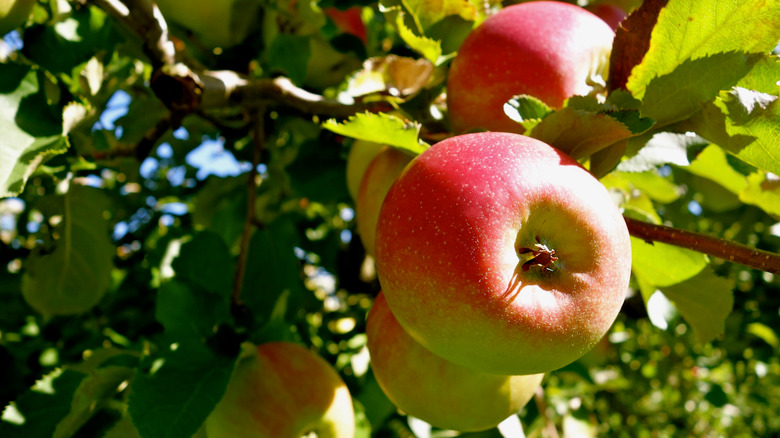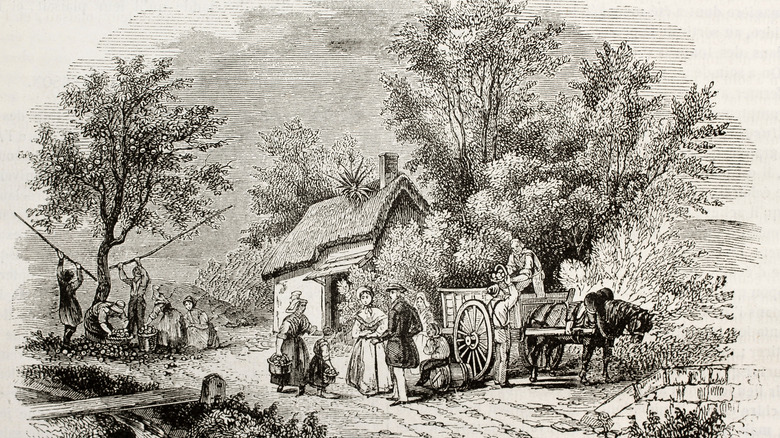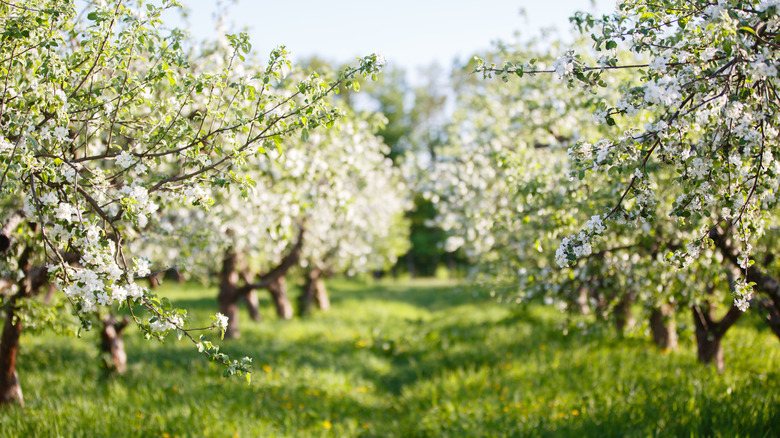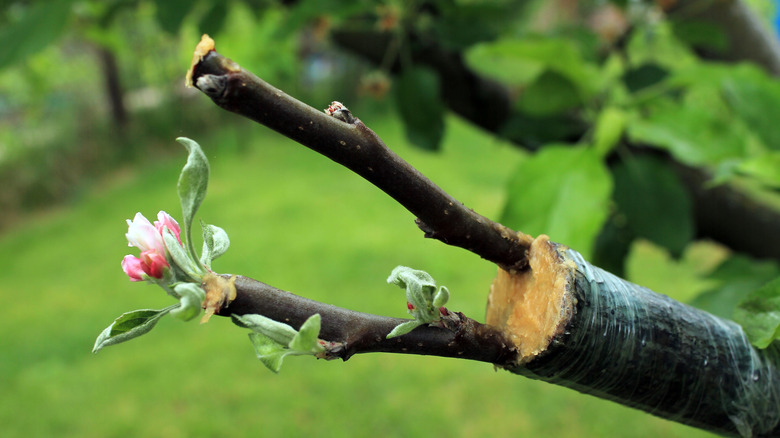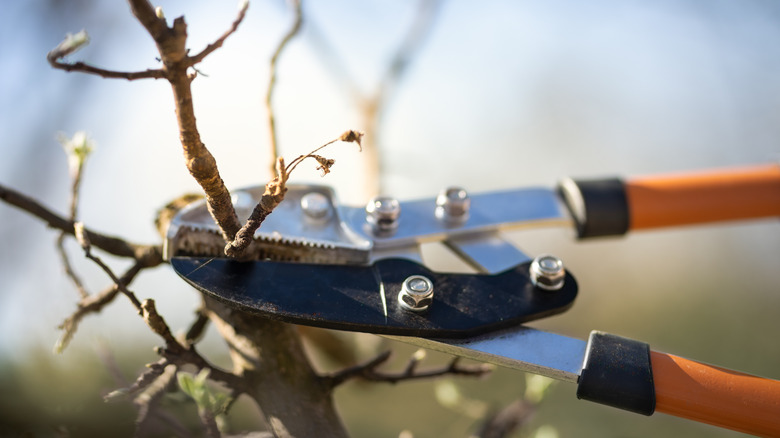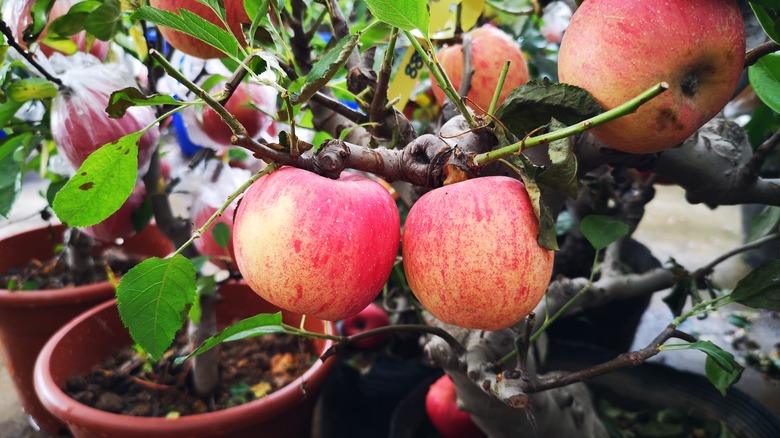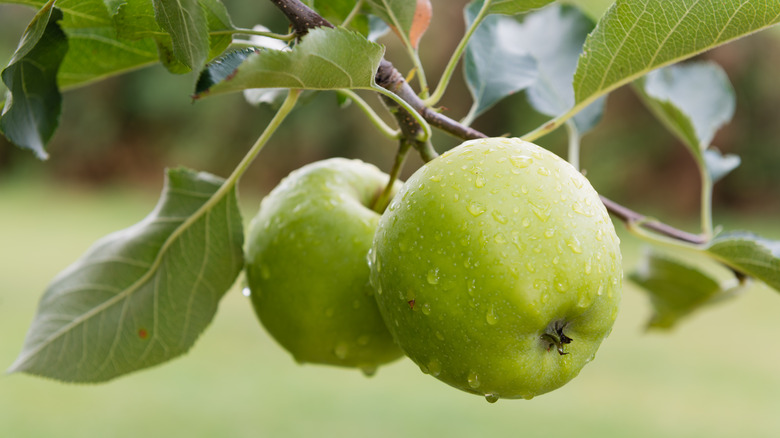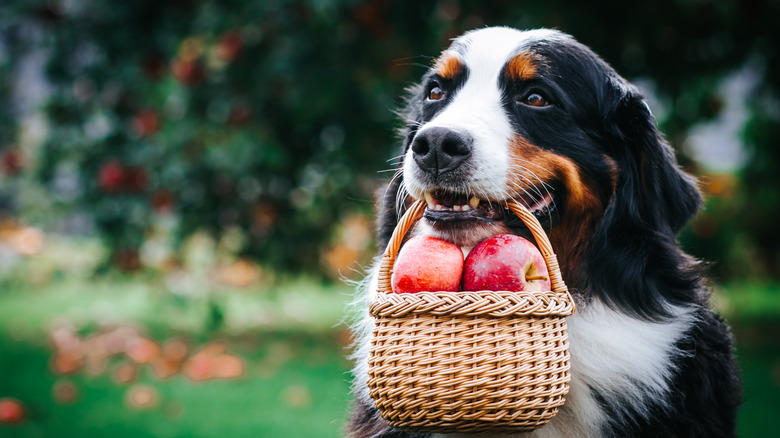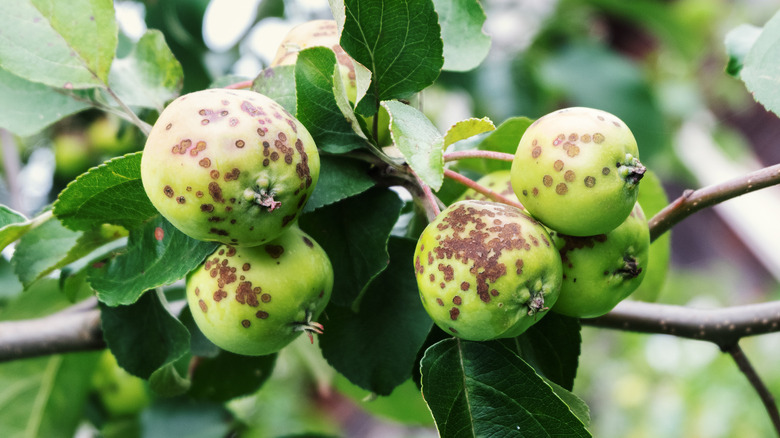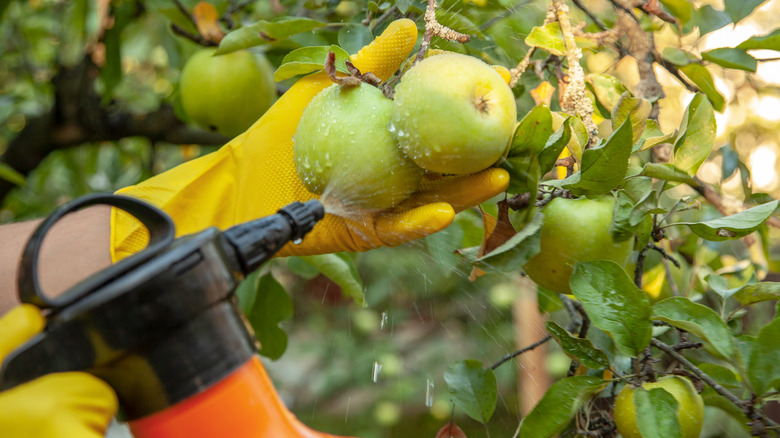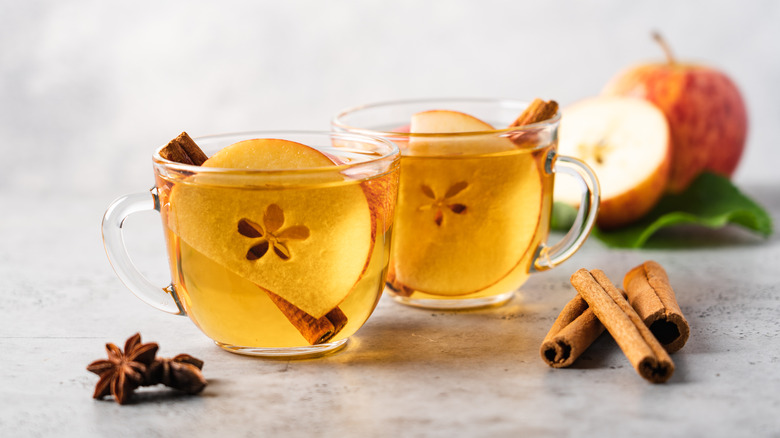How To Grow And Care For An Apple Tree
In 2019 alone, the United States commercially produced 11 billion pounds of apples, according to the Agricultural Marketing Resource Center, making them one of the most popular fruits. Apple trees are botanically classified as Malus domestica. Malus represents the genus. Domestica refers to all domestic varieties. From there, hybrid cultivar names become Malus domestica 'Fuji' or Malus domestica 'McIntosh,' and so on.
Whether you want a single apple tree for decoration or you've got the interest, space, and time to tend an orchard, the first step is to decide which cultivar is best for you. Of course, you want to pick a variety you enjoy eating, but it's even more important to pick a tree that will thrive in your particular climate zone; with apples, this matters a lot. We'll get into specific apple varieties later, but the basic gist, per The Old Farmer's Almanac, is that hardy apples grow well in USDA hardiness zones 3 through 5, and long-season apples live their best life in zones 5 through 8.
Most apple trees require an average of 1,000 chill hours (extensive periods of cold weather that stays between 32 to 45 degrees Fahrenheit) per year, explains Orange Pippin Fruit Trees. That's a small window and it's the reason why regions such as the Pacific Northwest and Michigan down through New York state and Pennsylvania are the main commercial producers of apples here in the U.S. If you live in zone 9 or higher, it'll be difficult to keep an apple tree productive, although there are a few cultivars that can thrive with less than 700 chill hours.
Solo trees offer spring blossoms and summer shade, but in order for an apple tree to bear fruit, it needs pollen from another variety. This means planting two different trees in your yard or relying on pollen from neighboring crab apple trees.
The history of apple trees in the U.S.
Apples have flourished in America for so long that many of us believe them to be native, to the extent that we claim anything standard about our way of life to be "as American as apple pie." Yet, neither apples nor pies originated here. While it's possible that some inedible crab apples have their roots in U.S. soil, according to Smithsonian Magazine, the apples we love to eat are native to Asia and were brought here by Europeans in the 1600s.
According to an article by the Brooklyn Botanic Garden, by 1629, Jamestown's own Captain John Smith had witnessed apples thriving throughout the colony. He recommended that every settler plant at least a quarter-acre plot of orchard per 500 acres of total land. Historic Sites theorizes that these settlers would have depended upon the versatile apple to feed a large family. They could be snacked on straight from the tree, baked into numerous dishes, and squashed into cider and vinegar. Because apple trees propagate easily, it wasn't long before they spread throughout the entire eastern seaboard.
Fast forward to the early 1830s and the arrival of a peculiar man named John Chapman, who literally walked the practice of growing apples from seed into the frontier west of Pennsylvania. In time, Chapman would plant orchards across 100,000 square miles of prairie, rightly becoming the legend known as Johnny Appleseed (via the Library of Congress). Many of his apples would have been too bitter to eat, but that wouldn't stop this pervasive fruit from morphing itself into a national staple.
How to use an apple tree in an orchard or landscape setting
You've read the complete history of Johnny Appleseed, you've picked out the cultivars you know will make the best-tasting pies and cider, and you're ready to get your trees into the ground. Before planting, stroll around your yard and take note of everything already in place. The Arbor Day Foundation calls this a sight analysis. You're looking to see where you've got the most free space, which areas receive the longest duration of direct sunlight, and if there's access to natural water sources and/or man-made irrigation (which could simply mean your garden hose).
Root systems spread out underground to anchor trees and search for water and sustenance. Though your trees will be small saplings when you bring them home from the garden center, consider how big they will get in the future — up to 25 feet tall with a 35-foot crown spread — and plan accordingly. The best spot for planting is one that will keep saplings from having to compete for what they need. The most important factor is direct sun. Do not plant an apple tree sapling in an area that will be shaded by other nearby trees or tall buildings.
For multiple apple trees, the Arbor Day Foundation recommends spacing standard trees 35 feet apart and dwarf varieties 10 feet apart.
How to propagate and grow an apple tree
Propagating trees is a whole lot more involved than propagating your average houseplant. According to North Dakota State University, the standard methods are called grafting, budding, and layering.
Grafting requires a rootstock, which is the lower part of a trunk that roots into the ground, and a scion, which is a cutting from whichever mature variety you want to grow. When the two pieces are combined in a graft, their tissues blend together at a cellular level. This is usually done when the trees are dormant and it allows the scion to receive nutrients and sustenance from the rootstock as it shoots further up and out. For a whip and tongue graft, identical cuts are made in both the rootstock and the scion so the pieces lock into each other and stay secure with no space between them.
Budding is a similar process that uses a bud as the scion grafted into a piece of bark from the rootstock. Both types of grafts can be taped or sealed with wax to help retain moisture and give the new offshoot the best chance at success. Though there are other grafting techniques, whip and tongue is considered the most successful.
Cooperative Extension explains that layering is different altogether. For this approach, a mature mother plant is cut back very close to ground level and new shoots are encouraged to grow up from the remaining base of roots. Soil, along with decomposed sawdust, is mounded over the base to maintain the health of its roots. This also forces the shoots to develop their own roots. When autumn arrives, the shoots have grown tall enough to become saplings that will grow into individual trees. They are removed from the base and the process is repeated the following season. Productive mother trees can keep this up for 20 years.
How to prune and care for an apple tree
Adding mulch to the area around your newly planted tree helps retain water, lowers the appearance of weeds, and insulates the soil from extreme temperature fluctuations, according to the Arbor Day Foundation. Young trees need more frequent watering than mature trees, and saplings may benefit from staking. The most important aspect of apple tree care is pruning, which they all require.
University of Minnesota Extension recommends pruning in March after the coldest temperatures have come and gone, yet before the start of new growth. There are many things to look out for when pruning, including dead or decaying branches; branches that are growing inward or downward, or rubbing against each other; limbs that are becoming thicker than the trunk; and young shoots (or suckers) making their way up from the underground roots.
Orchard managers at Stark Bro's say to start with a small set of clippers and a larger set of loppers. Work your way up from the bottom making sure you do not cut into the trunk or the central leader, which is the thickest branch growing straight up at the center. Thin out any unwanted branches with the end goal of creating a pyramid shape.
You'll want to prune your trees on a yearly basis, but other than that, it's time to settle in and wait. It can take up to 8 years for an apple tree to begin bearing fruit.
Container growing an apple tree
Perhaps the nicest thing about growing an apple tree in a container is that it will have no choice but to remain small and, therefore, potentially mobile. This is great for growers with minimal backyard space or simply none at all. A container plant can live its entire life on a porch, deck, or stoop provided it receives enough sunlight. Heck, it could even find a home on a small balcony. And come to think of it... according to Stargrow, there is a variety called Romeo...
Generally speaking, dwarf varieties should not grow taller than 6 feet, therefore, these are the most common trees for containers. Orange Pippin Trees points out two other approaches to picking the right tree for your patio. A slow-growing or dwarf fruit tree variety is one option. The other is to choose whichever vigorous cultivar you want and allow the container to force the rootstock to stay petite, thus limiting overall tree growth.
It's important to keep container trees well watered. Because they have so much less soil with which they can retain or extract water, they need more frequent tending than trees in the ground.
Regarding the potential mobility of potted apple trees, you have to resist your instinct to bring it into the kitchen during the winter so it can cozy up with a mug of hot chocolate. Apple trees cannot survive sudden extreme changes in environment or temperature. Remember that they require a minimum number of chill hours per calendar year. A frost-free garage will provide more than enough shelter. If you don't have an unheated indoor space, you can wrap the base of the tree with a protective fleece and keep it under a covered porch.
Apple tree varieties
There are some 30,000 varieties of apple trees in the world, according to Agri Benchmark, yet only about 30 of them are regularly grown and harvested. Even so, you've likely stumbled across an interesting new variety from time to time because fruit breeders have figured out how to speed up the hybrid cultivation process, explains Penn State Extension. To get you started, here are some varieties to consider depending on the average chill hours of your region and the overall growth size you can accommodate.
Standard Trees
All apple trees will grow and produce fruit in areas that receive 1,000 chill hours. Most will only thrive within that environment. Among them are 'Honeycrisp', 'Liberty', 'Spartan', 'Chehalis', 'Cortland', 'Red Delicious', and many more.
Medium (700-1,000) chill hour varieties
Popular apples that thrive within the medium range of chill hours include 'Fuji', 'Pink Lady', 'Gala', 'Crispin', and 'Granny Smith' (pictured above).
Low (less than 700) chill hour varieties
For those living in warm temperatures zones, there are a few cultivars that require less than 700 chill hours per year. These are 'Anna', 'Dorset Gold', and 'TropicSweet' (via UF IFAS Extension).
Dwarf varieties
Stark Bro's offers a wide range of dwarf varieties of most of the standard apple trees. Some will remain petite, topping out at only 3 feet tall. If you're really into tiny trees, you can even trim yours into a bonsai.
Are apple trees toxic?
Consuming the flesh and skin of apples is a healthy habit enjoyed by humans everywhere, but it's not the best practice for pets. If an apple a day keeps the doctor away, you're probably wondering how it could also be toxic. The problem is that, although we throw away the core, our pets ingest it all. The stems, leaves, and seeds of apples contain cyanide, which is what has the potential to lead to poisoning. The ASPCA lists panting, shock, strained breathing, and dilated pupils as signs of distress in cats, dogs, and horses who have consumed too much cyanide.
It's unlikely that anyone will consume a lethal dose, so don't fear the accidental consumption of a few apple seeds. Britannica explains that humans can digest and process small doses of the poisonous chemical compound that comes from cyanide. That said, it's best to keep this healthy snack to yourself instead of sharing it with your fur-covered companion.
Common pests and fungal diseases with apple trees
Pictured above, apple scab is a fungal disease that comes from spores growing in dead leaves, which become airborne via a gush of wind. Complete removal of all affected fruit and fallen leaves will be necessary. Furthermore, trees will likely need to be treated with zinc and urea, as well as fungicide, particularly in moist regions, according to Plant Village.
A second common fungal issue with apple trees is black rot, which can be identified by larger purple and brown lesions that lead to severely rotten fruit. The spores that cause black rot remain on tree branches through the winter and then spread thanks to the help of rainfall. Prune and burn any dead limbs and affected fruit, and again apply an appropriate fungicide.
If just the leaves are showing signs of distress with orange splotches surrounded by a darker red color, it may be cedar apple rust. To avoid this fungal disease, refrain from planting apple trees near cedar trees. If you do not have this option, there are cedar rust resistant apple tree varieties.
Some of the most common pest issues with apple trees are aphids, leafhoppers, and codling moths. There is even an insect called the apple maggot. Management can be as simple as a strong blast of water from your garden hose to knock the bugs off the leaves, or as complicated as setting sticky traps and working with insecticides.
Best fertilization practices for apple trees
It can be surprisingly easy to make mistakes when fertilizing apple trees, inadvertently harming the very plant you've worked hard to cultivate. With a little research and education you can learn exactly when and how to do so properly. If possible, start with a soil test. The results will yield a wide range of information about which nutrients are in your soil and which are lacking.
Grow Organic says to start feeding your trees in the spring before buds open with a high-nitrogen content fertilizer. Continue to feed through the remainder of spring and into summer, but cut back on the nitrogen before August arrives in order to stop the stimulation of new growth. For an all-natural nitrogen boost, look to composted chicken manure, blood meal, and soybean meal, among others.
In regards to the physical application of your chosen fertilizer, you're going to mix it into the ground surrounding the tree. Leave clear a 12-inch perimeter around the trunk of the tree. Then apply fertilizer to the soil outwards towards the drip line, meaning just underneath the farthest reaches of the tree's canopy. From there, gently rake and mix it into the ground.
Foliar sprays applied directly to fruit are another way to increase health and productivity by increasing micro and macronutrients, e.g. manganese, iron, and magnesium. Per Orchard People, common household ingredients can be used to make a homemade spray. These include kelp, fish emulsion, herbal tea, and quite unexpectedly, Coca-Cola due to its sugars and phosphorous which can be digested by leaves. Just be sure to dilute it first at 4 ounces of Coke to 1 gallon of water.
Nutritional value, recipes, and more
Apples are widely regarded as a healthy snack food. Harvard School of Public Health says they are excellent sources of fiber, phytochemicals, and Vitamin C. In the world of gastronomy, apple recipes run the gamut from drinks to desserts to salads. Chefs love experimenting with this fruit because it tastes just as good in sweet concoctions as it does in savory or spicy dishes.
And then there's apple cider vinegar, which practically takes on a life of its own. ACV, as the health-conscious call it, can be consumed straight or mixed into salad dressings and tonics. Per Healthline, it's not just antimicrobial and antioxidant; apple cider vinegar has been shown to aid in diabetes management by lowering blood sugar and improving insulin function.
ACV can be applied topically in the fight against skin conditions such as eczema and psoriasis. It also contains alpha hydroxy acid, which can diminish the appearance of age spots and wrinkles. It is always recommended to use ACV in moderation along with the guidance of a medical professional.
